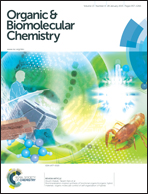The synthesis of [18F]pitavastatin as a tracer for hOATP using the Suzuki coupling†
Abstract
Fluorine-18 labeled radiotracers, such as [18F]fluorodeoxyglucose, can be used as practical diagnostic agents in positron emission tomography (PET). Furthermore, the properties of pharmaceuticals can be enhanced significantly by the introduction of fluorine groups into their original structures, and significant progress has been made during the last three decades towards the development of practical procedures for the introduction of fluorine. The replacement of the fluorine atoms present in pharmaceuticals with radioactive 18F atoms is a rational approach for designing novel PET tracers. As a fluorine-containing pharmaceutical agent, pitavastatin has attracted considerable interest from researchers working in the life sciences because it can act as an antihyperlipidemic agent as well as a substrate for hepatic organic anion transporting polypeptides (hOATP). With this in mind, it was envisaged that [18F]pitavastatin would be used as an excellent imaging agent for hOATP, which prompted us to investigate the synthesis of this agent. Herein, we report a practical method for the synthesis of [18F]pitavastatin by the Suzuki coupling reaction of p-iodofluorobenzene and a quinoline boronate derivative, with the desired product being formed in a radiochemical yield of 12 ± 3% (decay corrected from [18F]fluoride ions, n = 3).
![Graphical abstract: The synthesis of [18F]pitavastatin as a tracer for hOATP using the Suzuki coupling](/en/Image/Get?imageInfo.ImageType=GA&imageInfo.ImageIdentifier.ManuscriptID=C4OB01953A&imageInfo.ImageIdentifier.Year=2015)

 Please wait while we load your content...
Please wait while we load your content...